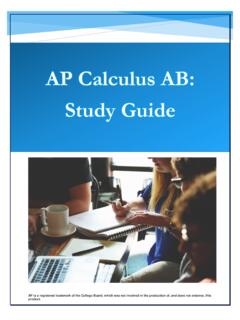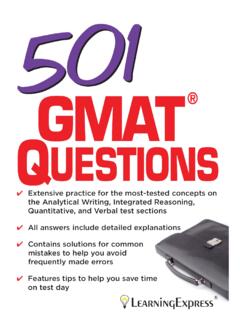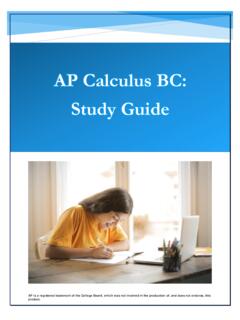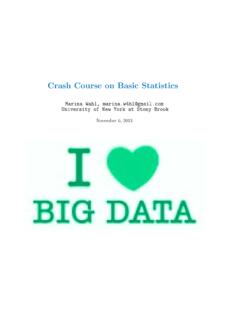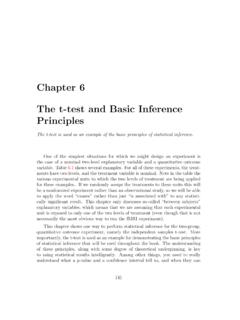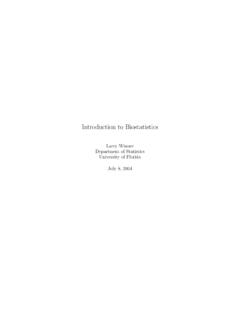Transcription of AP Statistics: Study Guide - EBSCO Information Services
1 AP Statistics: Study Guide AP is a registered trademark of College Board, which was not involved in the production of, and does not endorse, this product. Key Exam Details The AP Statistics course is equivalent to a first-semester, college-level class in statistics.
2 The 3-hour, end-of-course exam is comprised of 46 questions, including 40 multiple-choice questions (50% of the exam) and 6 free-response questions (50% of the exam). The exam covers the following course content categories: Exploring One-Variable data : 15% 23% of test questions Exploring Two-Variable data : 5% 7% of test questions Collecting data : 12% 15% of test questions Probability, Random Variables, and Probability Distributions: 10% 20% of test questions Sampling Distributions: 7% 12% of test questions inference for categorical data : Proportions: 12% 15% of test questions inference for Quantitative data : Means.
3 10% 18% of test questions inference for categorical data : Chi-Square: 2% 5% of test questions inference for Quantitative data : Slopes: 2% 5% of test questions This Guide will offer an overview of the main tested subjects, along with sample AP multiple-choice questions that look like the questions you ll see on test day. Exploring One-Variable data On your AP exam, 15 23% of questions will fall under the topic of Exploring One-Variable data . Variables and Frequency Tables A variable is a characteristic or quantity that potentially differs between individuals in a group.
4 A categorical variable is one that that classifies an individual by group or category, while a quantitative variable takes on a numerical value that can be measured. 1 Examples of Variables categorical variables The country in which a product is manufactured The political party with which a person is affiliated The color of a car Quantitative variables The height, in inches.
5 Of a person The number of red cars that pass through an intersection in a day It is important to recognize that it is possible for a categorical variable to look, superficially, like a number. For example, despite being composed of numbers, a zip code is categorical data . It does not represent any quantity or count; rather, it s simply a label for a location. Quantitative variables can be further classified as discrete or continuous. A discrete variable can take on only countably many values. The number of possible values is either finite or countably infinite.
6 In contrast, a continuous variable can take on uncountably many values. An important characteristic of a continuous variable is that between any two possible values another value can be found. Graphs for categorical Variables A categorical variable can be represented in a frequency table, which shows how many individual items in a population fall into each category. For example, suppose a student was interested in which color of car is most popular. He collects data from the parking lot at school, and his results are shown in the following frequency table: Color Frequency Black 14 Red 6 Blue 5 Silver 11 White 6 Green 3 Yellow 1 Grey 4 2 A relative frequency table gives the proportion of the total that is accounted for by each category.
7 For example, in the previous data , 14 of the 50 cars, or 28%, were black. The full relative frequency table is as follows: Color Relative Frequency Black 28% Red 12% Blue 10% Silver 22% White 12% Green 6% Yellow 2% Grey 8% Note that the percentages add up to 100%, since all of the cars were of one of the colors represented in the table. A bar chart is a graph that represents the frequencies, or relative frequencies, of a categorical variable. The categories are organized along a horizontal axis, with a bar rising above each category.
8 The height of the bar corresponds to the number of observations of that category. The vertical axis may be labeled with frequencies or with relative frequencies, as in the following examples. A bar chart representing data from more than one set is useful for comparing the frequencies across the sets. For example, suppose that the day after collecting the initial data on car colors, the student collected the same Information from a parking lot at a nearby school. The results can be compared using the following bar chart, which shows the relative frequencies for each color, separated by school: 3 Graphs for Quantitative Variables A histogram is related to a bar chart but is used for quantitative data .
9 The data is split into intervals, or bins, and the number of data points in each interval is counted. The horizontal axis contains the different intervals, which are adjacent to each other, as they form a number line. The vertical axis shows the count for each interval. The following histogram represents the scores that 50 students received on a test: How the data is split into intervals can have a big impact on the appearance of the histogram. Two histograms that represent the same data can show different characteristics, depending on the choice of interval width.
10 4 A stem-and-leaf plot is another graphical representation of a quantitative variable. Each data value is split into a stem (one or more digits) and a leaf (the last digit).




